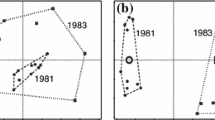Abstract
The development of non-linear ordination techniques has stemmed in part from work suggesting that species behave non-linearly to changing environmental factors or gradients. Developments in this area can be seen in two related phases: new algorithms, and the incorporation of new resemblance measures. Emphasis in this paper is placed on resemblance measures incorporated into a method of multi-dimensional scaling. The results show that a resemblance measure which reflects the non-linearities of the data can produce significant improvement in ordination, if the standardizations have not been too ‘severe’.
Similar content being viewed by others
References
Austin M. P., 1976. Performance of four ordination techniques assuming three different non-linear species response models. Vegetatio 33: 43–49.
Austin M. P., 1979. Current approaches to the non-linearity problem in vegetation analysis. In: Patil G. P. & Rosenzweig M. L. (eds.), Contemporary Quantitative Ecology and Related Ecometrics, pp. 197–210. ICPH, Fairland, Maryland.
Austin M. P., 1980. Searching for a model for use in vegetation analysis. Vegetatio 42: 11–21.
Brambilla, C. & Salzano, G, 1981. A non-metric multi-dimensional scaling method for non-linear dimension reduction. Istituto per le Applicazioni del Calcolo ‘Mauro Picone’. Quaderni, Serie III-N. 121. 35 pp.
Fasham M. J. R., 1977. A comparison of nonmetric multidimensional scaling, principal components and reciprocal averaging for the ordination of simulated coenoclines, and coenoplanes. Ecology 58: 551–561.
Feoli D. & Feoli Chiapella L., 1980. Evaluation of ordination methods through simulated coenoclines: some comments. Vegetatio 42: 35–41.
Forsythe W. L. & Loucks O. L., 1972. A transformation for species response to habitat factors. Ecology 53: 1112–1119.
Gauch H. G., 1973. The relationship between sample similarity and ecological distance. Ecology 54: 618–622.
Gauch H. G., Chase G. B. & Whittaker R. H., 1974. Ordination of vegetation samples by Gaussian species distributions. Ecology 55: 1382–1390.
Gauch H. G. & Whittaker R. H., 1972. Comparison of ordination techniques. Ecology 53: 868–875.
Groenewoud H. van, 1965. Ordination and classification of Swiss and Canadian coniferous forests by various biometric and other methods. Ber. Geobot. Inst. ETH Stiftg. Rübel, Zürich 36: 28–102.
Hill M. O. & Gauch H. G., 1980. Detrended correspondence analysis: an improved ordination technique. Vegetatio 42: 47–58.
Ihm P. & van Groenewoud H., 1975. A multivariate ordering of vegetation data based on Gaussian type gradient response curves. J. Ecol. 63: 767–777.
Johnson, R., 1973. A study of some multivariate methods for the analysis of botanical data. Ph.D. dissertation, Utah State Univ., Logan, Utah.
Johnson R. W. & Goodall D. W., 1980. A maxim likelihood approach to non-linear ordination. Vegetatio 41: 133–142.
Kendall D. G., 1971. Seriation from abundance matrices. In: Hodson F. R., Kendall D. G. & Tautu P. (eds.), Mathematics in the Archaeological and Historical Sciences, pp. 215–252. Edinburgh Univ. Press, Edingburgh.
Kruskal J. B., 1964a. Multidimensional scaling by optimizing goodness of fit to a nonmetric hypothesis. Psychometrika 29: 1–27.
Kruskal J. B., 1964b. Nonmetric multidimensional scaling: a numerical method. Psychometrika 29: 115–129.
Noy-Meir I. & Austin M. P., 1970. Principal component ordination and simulated vegetational data. Ecology 51: 551–552.
Orlóci L., 1978. Multivariate Analysis in Vegetation Research. 2nd ed. Junk The Hague. 451 pp.
Orlóci L., 1980. An algorithm for predictive ordination. Vegetatio 42: 23–25.
Phillips D. L., 1978. Polynomial ordination: field and computer simulation testing of a new method. Vegetatio 37: 129–140.
Werger, M. J. A., Louppen, J. M. W. & Eppink, J. H. M., 1983. Species performances and vegetation boundaries along an environmental gradient. Vegetatio (in press).
Whittaker R. H., 1956. Vegetation of the Great Smoky Mountains. Ecol. Monog. 26: 1–80.
Whittaker R. H., 1967. Gradient analysis of vegetation. Biol. Rev. 42: 207–264.
Whittaker R. H., 1972. Evolution and measurement of species diversity. Taxon 21: 213–251.
Author information
Authors and Affiliations
Additional information
One of the authors (L. Orlóci) was a recipient of an N.S.E.R.C. grant during the tenure of this project. The authors with to thank C. Brambilla and G. Salzano for the use of their computer program. A copy of a modified version used here may be obtained from the first author at no charge.
Rights and permissions
About this article
Cite this article
Fewster, P.H., Orlóci, L. On choosing a resemblance measure for non-linear predictive ordination. Vegetatio 54, 27–35 (1983). https://doi.org/10.1007/BF00036078
Accepted:
Issue Date:
DOI: https://doi.org/10.1007/BF00036078




